Apoie nossas
causas
Se mantenha informado de nossas ações
14 de March de 2024
In the steep terrain under the hot sun at Santana Farm in Aparecida (São Paulo) we find farmworker Douglas Pontes with a hoe in hand preparing the land to receive tree seedlings. Why? Well, the first batch of native seedlings got wiped out by a fire that started in the neighboring areas. Urban pressures compound the climate risks in an area that already faces significant degradation due to the economic cycles of coffee and cattle in the Paraíba Valley. "We're doing our part, but there's a lack of awareness around here," he says, hoping for success in the forest restoration project that puts food on his table and demands resilience—plus a good dose of stubbornness—due to the challenging landscape.
The National Sanctuary of Aparecida owns the premises, located alongside Presidente Dutra Highway at Km 336, buzzing incessantly with a steady stream of cars, buses, and trucks. This dynamic scene coexists with efforts to restore the forest and transform the hills in collaboration with SOS Mata Atlântica. At Santana Farm, where water sources supply the massive religious tourism infrastructure, walking to the newly planted areas reveals adversaries: brachiaria, the grass from old pastures that dominates the terrain, stifling the growth of new seedlings, and the voracious ants that target the plants arriving from the nurseries, requiring effective countermeasures.
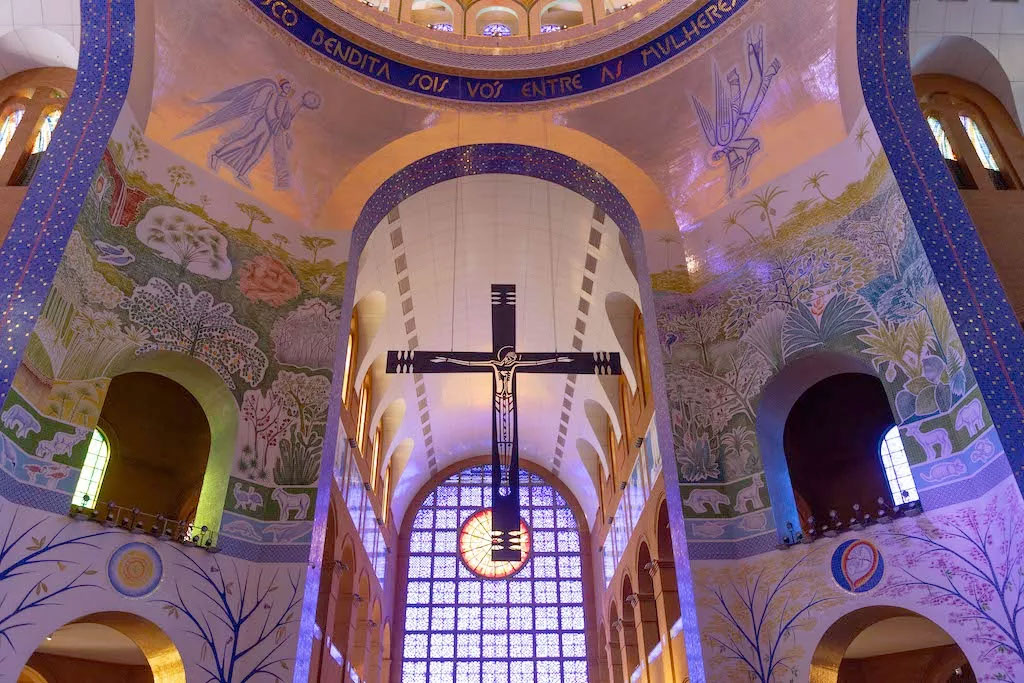

Aparecida Sanctuary and the Paraíba do Sul River in the background, seen from the viewpoint at Santana Farm, under restoration.
"It's an achievement earned day by day," Douglas explains, as he digs a small hole in the ground to plant the seedling, taking care to ensure that brachiaria grass doesn't take over. The daily grind in the field reflects how restoring the Atlantic Forest is tough, hands-on work, not magic, in the quest to tackle climate change, secure water, avert storm disasters, enhance quality of life, and bring back biodiversity. Given the impacts that have already taken place, the biome holds significant potential for restoration, with socio-economic potential as well. The active involvement of various stakeholders, including non-governmental organizations (NGOs), government bodies, landowners, financial supporters, local communities, and small forest businesses, is crucial in bringing this initiative to life.
In Aparecida, as the trees thrive, a complex network of services unfolds, and Douglas plays a pivotal role. "If it weren’t for this new job, I'd be doing what many others around here do— milking cows and earning 50% less," he explains, expressing optimism about the growing demand for restoring forests. "Back in the day, folks used to resist, wondering why we were putting so much effort into planting weeds and thorns, but now many recognize the importance of our work."
Labor Competition
The craft of planting tree seedlings is gaining more recognition, but there's a red flag waving. "It's highly sought-after workforce, facing competition from the construction sector and other urban activities. The younger generations aren’t interested in working hard in the fields, having to deal with the risk of snake bites and often without internet access," points out Fausto Balduíno da Silva, who runs Hummus, the forestry company in charge of executing planting operations for SOS Mata Atlântica in the Aparecida region.
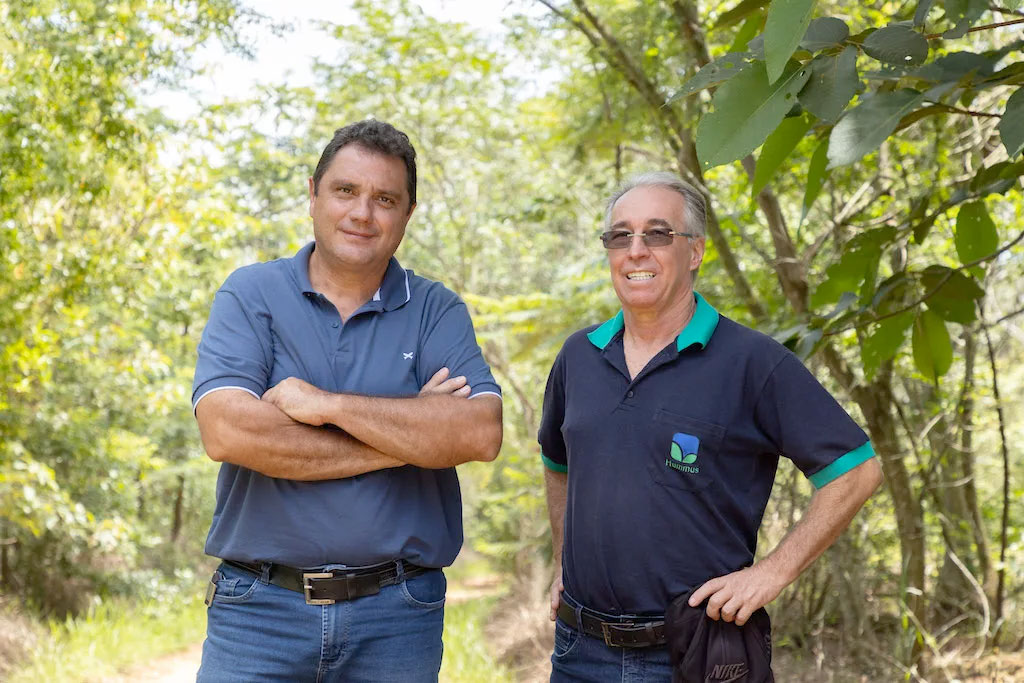
Fausto Balduíno and Amilton de Oliveira from Hummus, a planting company executing the restoration in Aparecida.
The business started some years ago, driven by the demand for eucalyptus from the paper and pulp sector. However, as that industry dwindled in the region, it paved the way for other land uses, particularly restoration of native forests. "It was like striking gold," says the agricultural engineer. A study from the University of São Paulo indicated there is potential to generate 2.5 million jobs through the reforestation of 12 million hectares, as outlined in the National Plan for Native Vegetation Recovery (PLANAVEG). This translates to roughly one job for every 2.3 hectares restored, equivalent to the size of two football fields, on average.
According to Fausto, farmworkers can earn salaries of up to R$ 3,000. To retain these workers, they are kept at home during dry seasons when planting activities are on hold. This impacts overall restoration costs, posing a challenge for scaling up the activity in the biome. It adds to a list of challenges that demand viable solutions. Fausto notes that, in Aparecida, a place where religion touches nature, replanting trees demands "technical expertise, hands-on experience, and a great deal of faith."
Mapping Local Realities
In 2016, SOS Mata Atlântica and the Sanctuary of Aparecida established a partnership with a clear mission: to restore 248 hectares of forests within the Sanctuary's grounds. This was a comprehensive effort that also involved environmental education, awareness initiatives, and community engagement. The diagnostic study, which laid the groundwork for this project, pinpointed opportunities for collaboration with 93 environmental initiatives identified in the municipalities of the Paraíba Valley in São Paulo, home to more than 500 tributary basins, each with multiple springs at risk of being adversely affected.
In the region, a mix of economic activities takes the spotlight, with agriculture, the automotive and aerospace industries, sand mining, and religious tourism leading the charge. This dynamic scene gets a boost from a network of urban services. And it's not just Aparecida making waves; other noteworthy spots include the Sanctuary of Frei Galvão in Guaratinguetá, Nova Gokula Farm in Pindamonhangaba, the Monastery of the Sacred Face in Roseira, and the Sanctuary Father of Mercies–Canção Nova in Cachoeira Paulista.
The situation we're dealing with today has deep roots, going back 13,000 years, when people first started interacting with nature on the American continent. First came the hunter-gatherers, then the nomadic farmers—and the story unfolded even more dramatically after the Portuguese colonizers arrived. "Unable to intellectually grasp the magnitude of what they had discovered, (...) they stumbled upon a continent driven by greed and virtue, without being swayed by compassion or even curiosity," wrote the Brazilianist Warren Dean in the classic work "With Broadax and Firebrand: The Destruction of the Brazilian Atlantic Forest". Gold, cattle, sugar, coffee—they went after everything. As industrialization and urbanization took off, the Paraíba Valley became one of the main targets of destruction.
Morros de Aparecida, new shades of green
The Santana Farm, initially donated to the Sanctuary of Aparecida and leased for cattle farming, is currently undergoing a transformation. With the cattle gone, the land has received 282,000 native seedlings, in addition to 187,000 from the nearby São José Farm, where Cruzeiro Hill is located, the final destination of the cable car that treats tourists to a sweeping view of the basilica. Just a short distance away, in the Paraíba Valley, seedlings have taken root at the Sobradinho Farm, which is under the ownership of the Sanctuary in Taubaté (SP). This region has strategic importance because it’s springs supply the mineral water sold in the religious-tourist complex.
The planting initiatives in the region were carried out through the Forests of the Future program, run by SOS Mata Atlântica since 2004. The program unites civil society, private enterprises, landowners, and the government in collaborative projects aimed at restoring forests. Individuals and companies can contribute in two ways: volunteer participation or mandatory compensation in the state of São Paulo, through the Environmental Recovery Commitment Agreement (TCRA).
The program facilitates collaboration between donors and rural landowners who are seeking to restore areas to comply with the Native Vegetation Protection Law (12.651/12). Seedlings are strategically planted after priority areas for restoration have been mapped in the biome. The NGO teams up with plant nurseries and service providers to diagnose areas, plant seedlings, maintenance and monitoring. This effort boosts the restoration chain, scaling up the number of plantings. In Aparecida, a grand total of 470,000 seedlings have been planted, thanks to the generous contributions from volunteers or mandatory compensation initiatives.
The Role of Religiosity
At the highest point of Santana Farm, a lookout offers a view of the unfolding restoration endeavors and the Paraíba do Sul River as a backdrop to the Sanctuary. Spread across 143,000 square meters, this spot sits almost dead center between Brazil's two biggest and wealthiest cities—São Paulo and Rio de Janeiro. Nestled next to a shopping mall, a tourist train chugs along towards the site, along the Paraíba do Sul's banks. Legend has it that, in 1717, fishermen stumbled upon the image of the Virgin Mary here, marking the beginning of devotions. Along a hike down the Rosary Pathway, seedlings have been planted with the assistance of SOS Mata Atlântica through public awareness initiatives, which center on the relationship between the forest and the river's water quality.
The current efforts to restore the forest in the area resonate with the ideas put forth by Pope Francis in 2015 in his encyclical Laudato Si, which urged people to "take care of our shared home." In this 184-page document, he delved into the human roots of the ecological crisis, shedding light on ideologies and economic trends that have sparked environmental problems, such as the unbridled use of technology to manipulate and control nature. One of the key concepts presented in the document is that of "integral ecology", which views humans as integral components of a broader world. This perspective calls for "integral solutions that take into account how natural systems interact among themselves and with social systems." It includes the ethical and spiritual dimensions of the environmental paradigm.
In Aparecida, the grand dome of the basilica houses one of the most popular attractions—frescoes showcasing animals, plants, and other elements of Brazil's diverse biomes. It's a stunning blend of nature and faith. The temple, along with the tourist facilities, welcomed 8.8 million visitors in 2023—a 10% increase from the previous year, gradually getting back to the pre-pandemic averages of 12 million visitors per year.
Reflections on Social Issues
In this beautiful backdrop, a showcase for environmental themes, the effort to replant trees has social impacts. In the city of Aparecida, Casa do Pequeno is committed to helping the families of around 2,500 employees of the religious complex. They offer daycare services, organize workshops for professional development and activities for the elderly. Ana Luísa Taschetto, the Communications and Environmental Manager at the Sanctuary, explains, "We faced significant challenges from environmental impacts, particularly fires caused by urban expansion." She plans to bring more attention to the issue in the activities held with pilgrims and local communities. "Investing in forest restoration is also a way of giving something back to compensate for the expansion of our structure," she explains.
After creating an environmental agenda, projects like SOS Paraíba, which includes monthly monitoring of the river's water quality, were put into action. The focus areas of this agenda are: harmonious living with nature, waste recycling, fostering community well-being, and creating vegetable gardens. Some of the activities included training workshops for managers and video presentations during visits to the Center for Forest Experiments in Itu (SP), run by SOS Mata Atlântica.
"It's crucial to reconnect children and their families with the Atlantic Forest, which is their home," emphasizes Ana Luísa, noting that forest restoration provides an excellent opportunity to discuss climate change, a topic that is still absent from local concerns.
Sister Zuleide Savi Daros, who heads Casa do Pequeno, emphasizes, "We need a closer connection between faith and the reality of people in the city and its surroundings, where poverty and social vulnerability are high." Planting a forest, she adds, "encourages reflections and dreams, bringing joy and a sense of connection." In the socio-environmental scenario, planting large numbers of trees in the neighborhood sparks teamwork reminiscent of ants' industrious efforts, bringing about positive changes. In this case, the unwelcome ants—usually dreaded by young plants—are indeed welcomed.
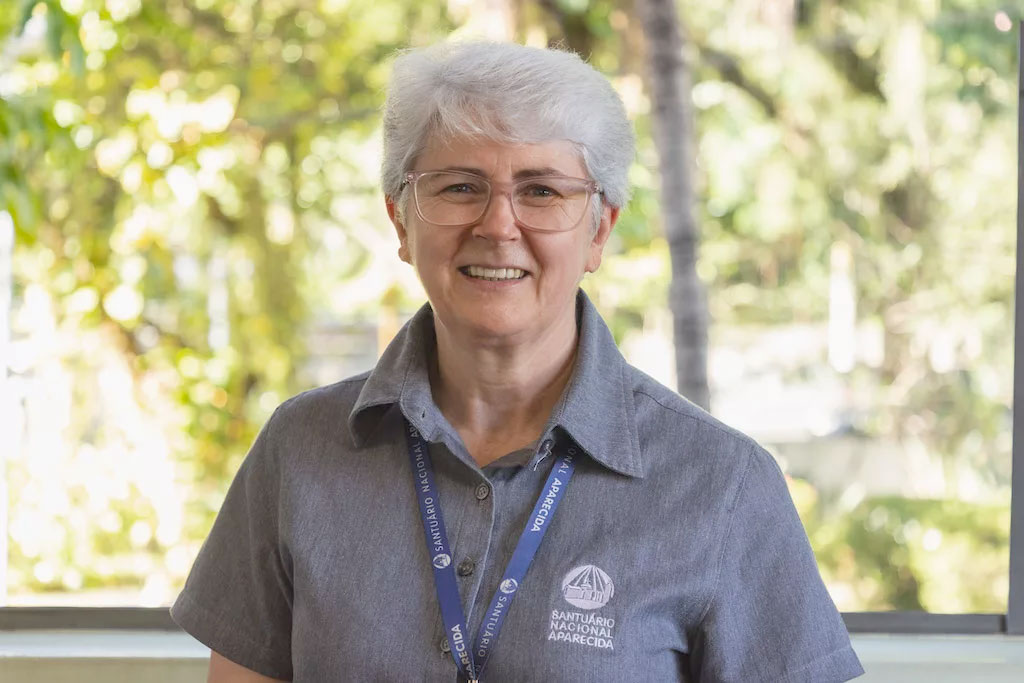
Irmã Zuleide Daros, director of Casa do Pequeno.

Casa do Pequeno conducts socio-environmental actions at the Sanctuary.
Frei Galvão, on the Same Path
In the nearby town of Guaratinguetá (SP), just a street away from Aparecida in the Paraíba Valley, the marriage between faith and forest restoration is perfectly captured in the new structure dedicated to the devotion of Frei Galvão—a Brazilian Franciscan friar who became the first saint born in Brazil, canonized by Pope Benedict XVI in 2007. A sign at the foot of the friar's statue, positioned at the entrance of the site, states: "By planting 3 thousand Atlantic Forest tree seedlings at Laudato Si Park, we've concluded the first construction stage for the new sanctuary."
Partnering with SOS Mata Atlântica, a stretch of land was restored along the banks of a stream in an Urban Permanent Preservation Area (APP) provided by the municipality. This area was under the looming threat of urban expansion. "The goal is to create a space for both recreation and spiritual activities, centered on nature contemplation," explains Friar Leandro Costa Santos, in charge of communications at the Sanctuary. He underscores how important ecology is to the Franciscans, where it frequently takes on a charismatic role, particularly emphasized in the Laudato Si encyclical. The papal letter opens with a quote from Saint Francis of Assisi's Canticle of the Creatures, in which the saint praises God by reflecting on the goodness of the sun, wind, earth, water, and other natural forces.
"Nature is like another page from the Gospel, where we see God," shares Friar Leandro. It's no surprise, he notes, that the new religious complex, located behind the current sanctuary, decided to prioritize forest restoration. "This clearly signals our commitment to caring for nature," adds the friar.
Laudato Si Park will be open to the public and is set to occupy 20% of the new visitor structure, with an estimated cost of R$ 400 million. "Reflections on faith and life should accompany ecological actions," stresses Friar Leandro, standing near the spot where the renowned "pills of Frei Galvão" are handed out. These edible rice paper pills come with a prayer dedicated to the Virgin Mary and are meant to be taken over a nine-day period called a novena.
Beyond religion, Friar Leandro also emphasizes the importance of rallying the community to embrace the area and tackle the challenges posed by urban development. Potential threats are on the horizon, such as the neighborhood horses causing harm to the young seedlings. Friar Leandro urges, "We need to have faith, but also take precautions."
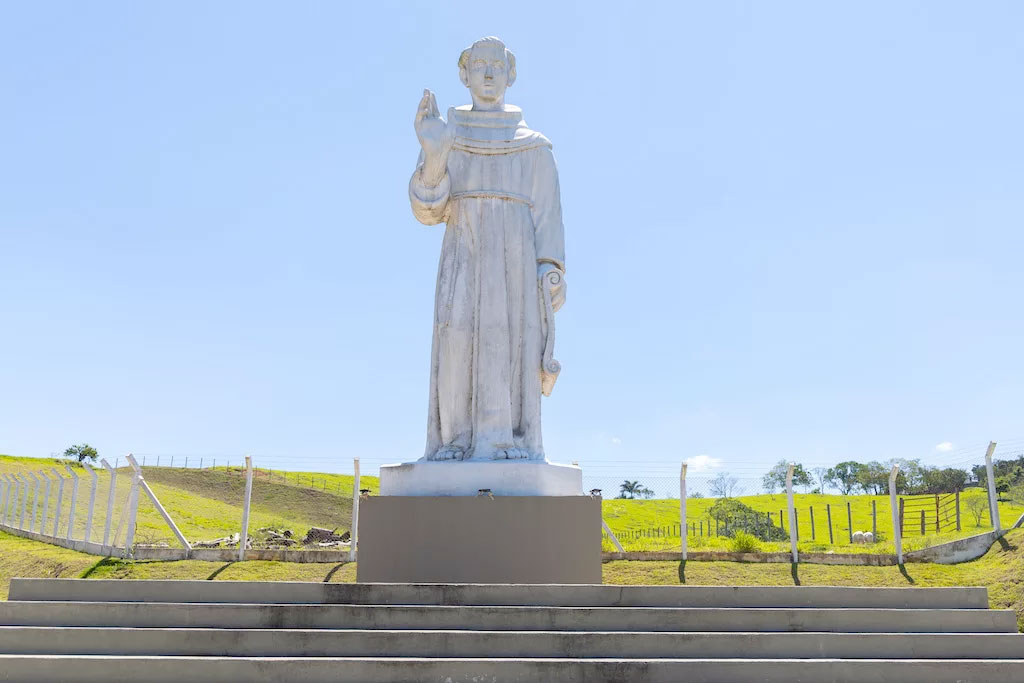
Frei Galvão statue in the terrain that will host the new santuary.

Permanent Preservation Area (APP, in Portuguese) restores on the Frei Galvão Sanctuary.
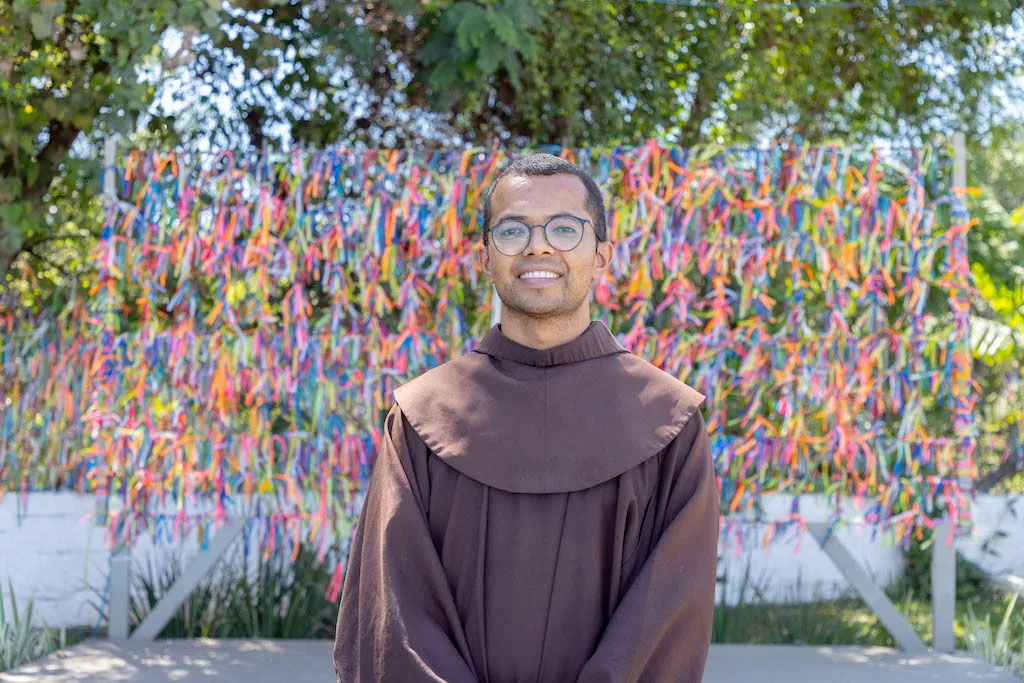
Frei Leandro Santos, coordinator at the Frei Galvão Sanctuary.
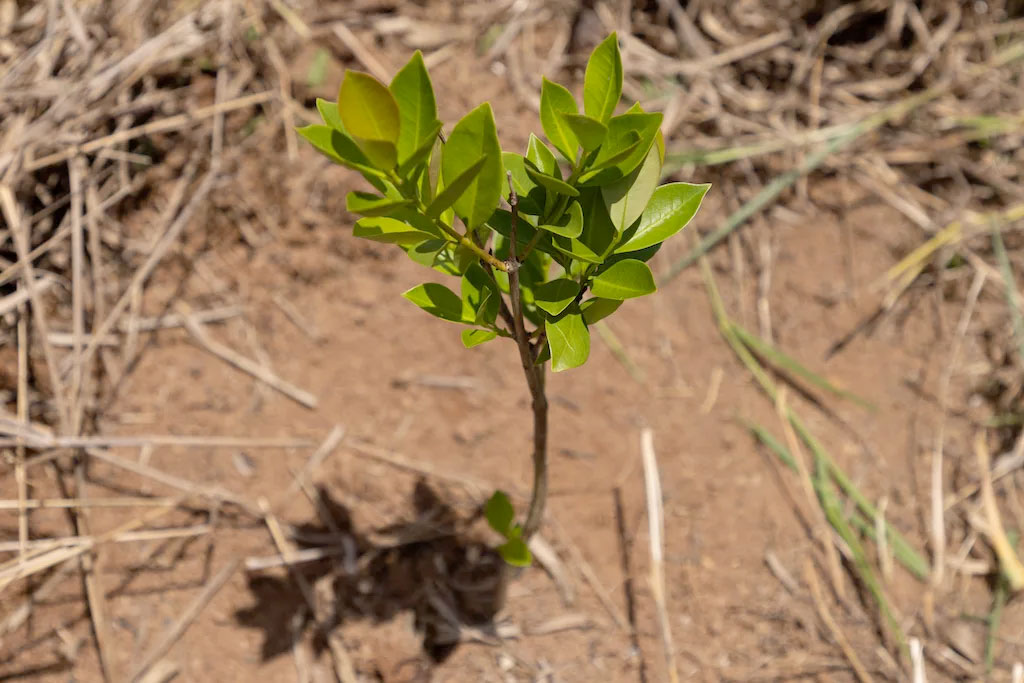
Araçá seedling planted in Aparecida.